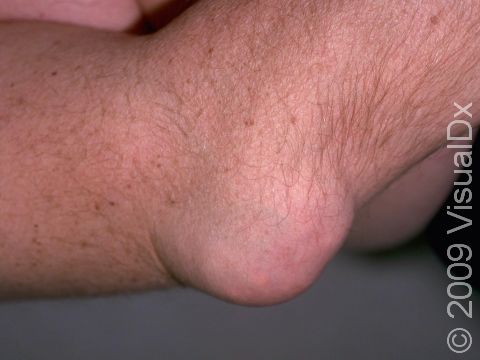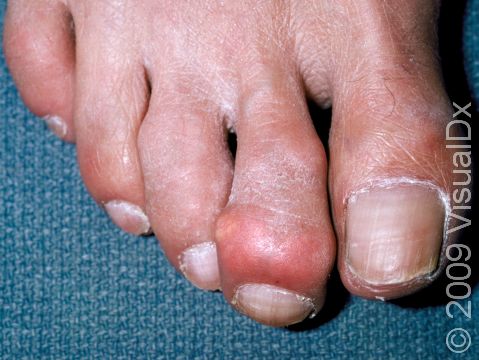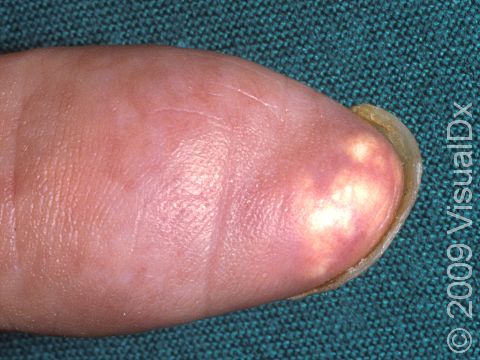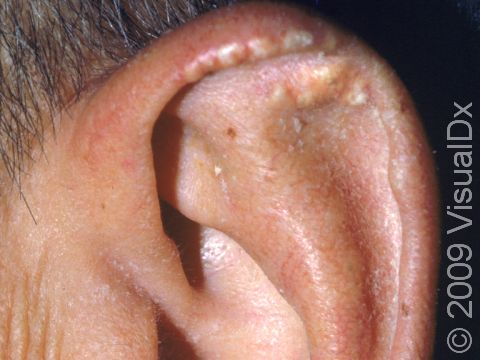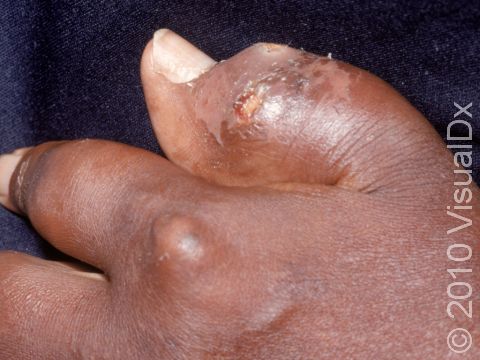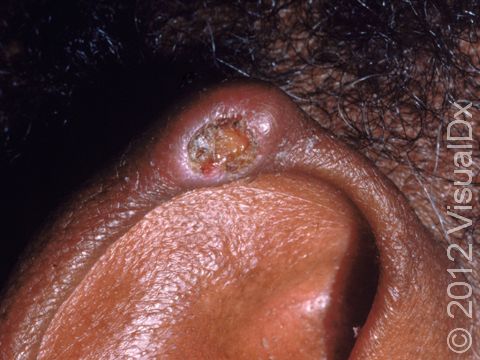Gout
Gout, also called gouty arthritis, is a disease of how the body processes nutrients (metabolism) in which crystals of uric acid are deposited in the joints, tendons, and skin. Most commonly affecting men, gout emerges as the sudden development of swollen, red, hot, tender joints, especially at the big (great) toe, ankle, wrist, and knee.
Uric acid is a substance resulting from the breakdown (metabolism) of purines, which are proteins found in human tissues and in many foods. Gout is caused by elevated levels of uric acid in the blood, due to either increased production of uric acid or decreased excretion of uric acid by the kidney. The excess uric acid is deposited as needle-like crystals in the cartilage and tissue surrounding joints, in the skin, and in the kidneys. These deposits cause inflammation, which can ultimately result in joint destruction, nodules called tophi, or kidney stones.
Gout is often diagnosed clinically, though several tests, including blood work and X-rays, are usually performed to confirm the diagnosis. The definitive diagnosis of gout is based on microscopic examination of fluid from an affected joint.
Who's At Risk?
Gout can affect people of all races, of all ages, and of either sex. However, certain races of people are more likely to develop gout, including Pacific Islanders, the Maori of New Zealand, and African Americans (but not black Africans). Gout is uncommon in children and young adults. In addition, men are far more likely to have gout than women, who rarely develop this disorder, especially prior to menopause.
Some individuals with gout have a genetic predisposition due to a disorder of purine metabolism. In these individuals, attacks of gout can be triggered by eating foods high in purines or by consuming high levels of alcohol.
Other people have secondary gout, in which gout develops in the context of another medical condition. These other conditions include:
- Obesity
- Diseases of the blood, including leukemia, polycythemia, and hemolytic anemia
- Diabetes
- High blood pressure (hypertension)
- Kidney disorders
- Certain medications such as diuretics (“water pills”), salicylates (aspirin), or niacin (vitamin B-3)
- Chronic lead exposure
Signs & Symptoms
The most common locations for gouty joints include:
- Great toe
- Ankle
- Wrist
- Knee
- Elbow
- Hand or fingers
- Spine
The classic picture of an acute gout attack is the sudden development of a painful, swollen, warm joint. The pain may be so severe that even a sheet draped across the affected joint is intolerable. A low-grade fever may also be present.
Mild attacks usually resolve quickly, but severe attacks can last days or weeks. The joint then appears normal and is pain-free.
After a period of many years, the chronic stage of gout may develop. In this stage, the disease has caused permanent damage to affected joints and, occasionally, to the kidneys. When uric acid deposits accumulate in the skin over long periods of time, they form small, rounded lumps (nodules) called tophi. These nodules vary in size, and they are yellow or cream in color. If the tophi become very large, they can erupt through the skin and discharge a chalky, white substance. The most common locations for tophi include:
- Rims of the ears
- Toes and fingers
- Achilles tendons
- Elbows and knees
Self-Care Guidelines
For acute attacks of gout, the following measures may be beneficial:
- Rest and elevate the affected joint, if possible.
- Apply ice packs for 20 minutes at a time, several times a day.
- Take ibuprofen for relief of pain and inflammation (unless you have a history of kidney disease or stomach ulcers).
- Avoid aspirin, as it can worsen the condition in some people.
- Apply hemorrhoid creams to the skin to temporarily reduce inflammation.
After an acute attack, skin overlying the affected joint may peel and shed. If this occurs on a toe joint, the area may be more likely to develop a fungal infection (athlete’s foot). Keep the area dry and use an over-the-counter antifungal cream, such as terbinafine or clotrimazole.
Patients with a history of gout should consider the following:
- Avoid foods high in purines such as anchovies, organ meat, red meat, asparagus, mushrooms, spinach, dried beans (as well as peas and lentils), and cauliflower.
- Limit alcohol consumption to 2 drinks per day if you are a man and 1 drink per day if you are a woman.
- Consume purine-neutralizing foods such as fresh fruits (especially cherries and strawberries), most vegetables, celery juice, and B-complex and C vitamins.
- Drink an extra 4–5 glasses of water per day.
- Maintain a healthy weight.
Treatments
The goals of treatment of gout are to reduce the pain associated with acute attacks, to prevent future attacks from occurring, and to avoid the formation of tophi and kidney stones.
Your physician may recommend one or more of the following treatments for acute attacks:
- Rest and elevation of the affected joint
- Anti-inflammatory medications, including ibuprofen, naproxen, or indomethacin
- Colchicine (an oral medication used to reduce inflammation)
- Corticosteroids (a type of anti-inflammatory medicine) such as triamcinolone injections or prednisone pills
For long-term treatment and prevention of recurrent attacks, your physician may recommend one or more of the following:
- Low-purine diet
- Colchicine
- Allopurinol (an oral medication used to prevent the formation of uric acid)
- Probenecid (an oral medication used to help the body eliminate uric acid)
In rare cases, surgical intervention may be required in the case of large tophi or to correct any joint deformities.
Visit Urgency
If you suddenly develop a painful, red, hot joint, see a physician as soon as possible. While the diagnosis may be gout, it could also be an infected joint. Treatment should be started immediately.
Trusted Links
References
Bolognia, Jean L., ed. Dermatology, pp.669-672. New York: Mosby, 2003.
Freedberg, Irwin M., ed. Fitzpatrick’s Dermatology in General Medicine. 6th ed, pp.1752-1754. New York: McGraw-Hill, 2003.
Last modified on October 10th, 2022 at 3:53 pm

Not sure what to look for?
Try our new Rash and Skin Condition Finder
